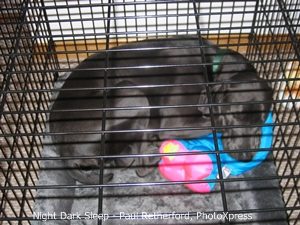Many dog trainers recommend the use of a “clicker” to improve communication between you and your dog. Until your dog learns a particular command, words mean nothing! Teach the behavior, then teach the command… Dogs learn quickly that the clicker sound means “good!”.
When you use force to achieve a behavior, you are doing all the thinking for your dog. Your dog will learn to avoid the correction rather than figure out on his own what you want.
WHAT IS A CLICKER?
A clicker is a small gadget that easily makes a distinct and consistent noise. Your dog learns that this particular noise has a meaning – “good dog!”. There are three basic clicker types, and which one you choose is more a matter of personal preference and budget. They all work the same.
- The Box clicker: This is the most common clicker and can found at any pet shop. The cost is under $4.00. ( You can often find promotional box clickers for around $1.00.)
- Star Mark clicker: This clicker’s shape and size make it a very user friendly model. The cost is under $6.00.
- Quiet Clicker: This clicker is best used for dogs that are sensitive to noise. They have adjustable volume settings and can adapt to your dog’s needs.
CLICKER TRAINING BASICS
No matter what trick or behavior you are trying to teach your dog, the clicker can help. Every time you click, you “mark” a behavior. The click tells your pet “YES, you have done the right thing.” Research also indicates that the click sound activates your dog’s mind and helps your pet learn to think and to focus.
Your goal is to click immediately when your dog does the desired action or behavior. Timing is critical – you only have 1.5 seconds to let your dog know that he has achieved the behavior that you wanted.
Here’s a simple clicker training example:
- Lure your dog into “sit” using a yummy treat.
- When he sits, click. Your dog might stand immediately after the click. This is normal. When you clicked, you told him that he did the right thing and is finished with the behavior.
- Give you dog a treat after every click. If you make a mistake and click at the wrong time you must give your dog a treat anyway. It is not your dog’s mistake and it will only confuse him if he is not rewarded.
Your dog will quickly learn when he hears a click, good things happen. All clicker training follows the same pattern.
NOTE: Never click to get your dog’s attention. The clicker should only be used to mark a behavior. If you click indiscriminately, you will confuse your pet.
Some dogs may find it difficult to learn new tricks and behaviors. Adding a “jackpot” reward can supplement clicks and treats and help your pet better recognize success.
- When your dog accomplishes the desired behavior, click, say “jackpot” enthusiastically and give multiple treats and praise. This will let your dog know that he has done something really special and that you are really pleased, so he will be more likely to offer the behavior again.
- Click only once and never give extra clicks. Only give your dog extra rewards and praise.
Beyond the basics
Your clicker is very handy for advanced training, as well. Using the techniques below, you can teach your dog all sorts of tricks!
Lengthening a behavior – hold that position!
After your dog learns a trick or behavior, you may want him to “hold” the position or to wait for further commands. This is called “lengthening the behavior” and it’s pretty simple.
- Give your dog a command, and count to three before clicking and treating.
- Repeat this process, but count to five before clicking.
- Wait longer and longer periods between clicks, and your dog will learn very quickly to hold his position until you click. Like magic, your dog will hold positions longer with very little effort.
BTW, you’ll want to count to yourself because speaking aloud will distract your dog!
Luring – coax your dog into the desired position or behavior
The simplest way to begin using the clicker is to lure your dog and then click as soon as you achieve the behavior that you want. To lure your dog use a treat and lead your dog into the correct position. Do not speak to your dog during this phase of training.
For example, to achieve a sit place a treat in the palm of your hand. Hold the treat under your thumb.
- Raise your hand slowly over your dog’s head and move it towards his tail. Your dog should raise his head following the treat, and his rear will go to the ground. Gravity works.
- Click immediately then treat. Try to get a quick succession of lure, click, treat. At this point you will be teaching a hand signal as you lure your dog.
Luring is based on the show-don’t-tell training principle. Your dog must learn a behavior before he learns the command.
Shaping – teach your dog in smaller increments
Shaping consists of taking baby steps towards a behavior. You can click for voluntary (or accidental) movements towards your goal.
- You may coax or lure your dog into a movement or position, but do not force the behavior. Let the dog discover how to perform the behavior on it’s own.
- Don’t wait for the whole picture of the perfect behavior. Click and treat for small movements in the right direction. It’s like playing hot and cold.
Example: You are luring your dog into the down position. Your pet will only look down toward his chest following the treat but will not complete the down. So, let’s build on the little bit of forward progress your dog is making.
- When your dog looks down, click and treat and repeating the exercise waiting for your dog to move closer to the down position.
- For every little movement that takes him closer to the ground you will click and treat.
- When he achieves the down position, click, treat and jackpot.
Chaining – joining multiple behaviors together into one trick
Chaining is a method that will help you achieve difficult or complex behaviors. It consists of combining small skills to teach a more complex maneuver.
A simple example is teaching your dog the old standby “play dead” trick.
- Teach your roll over using BANG! as a cue.
- Teach your dog to lay his head flat on the floor and to stay still playing dead.
- Teach him to him to stand up on his back legs or sit up.
After your dog knows all of his new tricks, combine them into “Stick em up!”
- Start with him standing on his back legs or sitting up on his hind legs, then use bang to get your dog to drop to the ground.
- Finish it with playing dead and have your dog fall on his side for a dramatic death.
There are many ways to use your clicker to it’s full advantage. All it takes is a bit of effort and creativity and you can achieve anything with your dog.
Capturing – reward and name a behavior that your dogs does on his own
Capturing is a unique and fun way to teach your pet new behaviors. It gives you the opportunity to take cute behaviors that your dog does naturally and turn them into a trick.
A simple example: Say that your dog lays down and places his paws over his nose.
- While sitting around with your pet wait for him to place his paw on his nose and click and treat. If you do this often enough he will get it.
- Add a word like “shy” as a command, and after he learns to respond to the word ask him “Are you shy?” he will then do his trick. How easy is that?
Another use for capturing is it gives you a way to teach your pet behaviors that he is having problems with. For example, if your dog is challenged by the “down” command:
- Have your dog on a leash, and stand on it so your hands are free. Don’t give your dog a lot of room to maneuver.
- Signal for a down. Then wait. It may take a while but with this method patience is a virtue.
- Do not say the word, down repeatedly. Let him think about what he should do.
- When your dog downs click and jackpot.
- Start again. Do not give up. Wait for it. It will happen.
Keep practice sessions short. Much more is learned in three sessions of five or ten minutes each than in an hour of boring repetitions. You can get dramatic results, and teach your dog many new things, by fitting a few clicks a day here and there into your normal routine.
 Crate training is one of the most misunderstood subjects in your pup/dog’s world. Folks may think that a crate is a horrible punishment – a jail used to confine your dog when he has been bad. In reality, dogs, like their wolf ancestors, are den animals. They feel secure and cozy in their dens, and the crate acts as a safe harbor in times of stress when dogs just need a break from us and all the frantic activity that seem to follow their humans.
Crate training is one of the most misunderstood subjects in your pup/dog’s world. Folks may think that a crate is a horrible punishment – a jail used to confine your dog when he has been bad. In reality, dogs, like their wolf ancestors, are den animals. They feel secure and cozy in their dens, and the crate acts as a safe harbor in times of stress when dogs just need a break from us and all the frantic activity that seem to follow their humans. “touch” command is you and your dog’s ticket to a world of new tricks and talents. Once your dog understands “touch” you can teach him to close cabinets, fetch items and perform other “chores”. And it is a remarkably easy command to learn!
“touch” command is you and your dog’s ticket to a world of new tricks and talents. Once your dog understands “touch” you can teach him to close cabinets, fetch items and perform other “chores”. And it is a remarkably easy command to learn!
 nto your home you must set them up for success. Those first hours or days with a new pet are stressful for both you and the dog!
nto your home you must set them up for success. Those first hours or days with a new pet are stressful for both you and the dog! signal that it needs to go and to wait until he can get to an “approved” potty location. During training, you’ll need to read subtle clues and proactively encourage your dog to potty regularly.
signal that it needs to go and to wait until he can get to an “approved” potty location. During training, you’ll need to read subtle clues and proactively encourage your dog to potty regularly.
